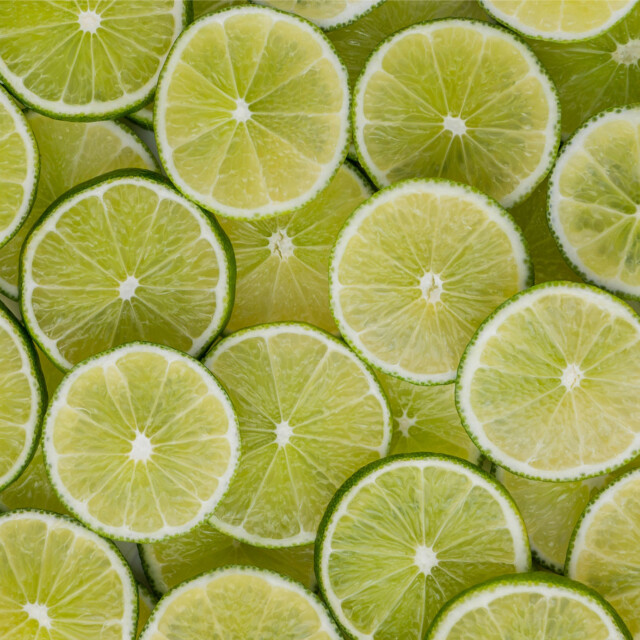Nearly every shaken cocktail, classic or modern, contains some form of citrus — and nine times out of 10, that means lemon or lime. As a result, cocktail bars around the world churn through cases of limes each week. Typically, someone comes in early to prep, juicing lime after lime until there’s enough juice for service. The next day, the routine repeats.
This is the ideal scenario — but it hasn’t always been the case. Freshly squeezed lime juice may be the gold standard today, but its widespread use is a relatively recent shift. Not long ago, bartenders mainly relied on sweet & sour mix. Before that, Rose’s Lime Cordial was the go-to sour component in many cocktails. That’s not to say fresh lime juice wasn’t utilized before the 21st century — it just wasn’t nearly as common as it is now.
Today, we’re in an era where molecular mixology is at a fever pitch, and more bartenders than ever are designing menus with sustainability in mind. This two-fold shift has led to a new wave of lime juice alternatives — far beyond the saccharine syrups and mixers of decades past. Enter products like Super Juice and Lime Acid. Not only do they last longer than fresh juice, they also yield a lot more liquid with far fewer limes — or in Lime Acid’s case, no limes at all.
At the end of the day, every bartender’s top priority is — or should be — making drinks that taste as good as possible, sustainability be damned. So which version of lime juice makes the best cocktail? We put them all to the test in classic Daiquiris to find out.
Why Daiquiris? Beyond being a litmus test for balance, the drink only contains three ingredients: light rum, sugar, and lime juice. When they’re in harmony, a Daiquiri sings. When something’s off, it’s easy to spot — whether it’s the proportions, ingredients, or dilution.
For consistency, we used VinePair’s house Daiquiri spec: a standard 1:1 simple syrup, Probitas White Blended Rum, one of the many forms of lime juice (or lime juice alternatives), and Kold Draft ice for each drink. All drinks were made back-to-back by the same bartender, Alec Kossoff of NYC’s Monkey Thief.
From sweet & sour mix and Rose’s Lime Cordial to Super Juice, day-old lime juice, and lime juice squeezed à la minute, we ranked every version of lime juice below on a scale of 1 to 10. Welcome to the acid test.
Sweet & Sour Mix (Zing Zang brand)
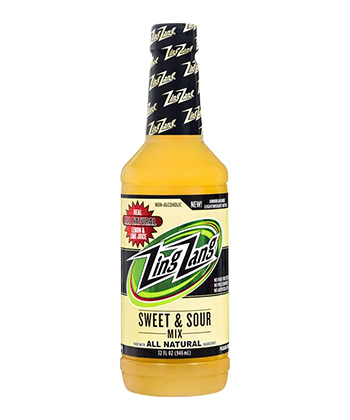
Sweet & sour mix has a bad rap these days. It’s a one-size-fits-all sweetener that rarely hits the mark, landing in an unsatisfying gray area between sweet and sour. The bottle we tested contained 20 percent juice (a mix of lemon and lime juices from concentrate). The rest of the ingredients were filtered water, cane sugar, citric acid, natural orange bitters flavor, stevia leaf extract, and beta carotene, the pigment that makes carrots orange. For what it’s worth, it contains no high-fructose corn syrup or artificial flavors.
In a Daiquiri, its appearance was on point, but faded after a few minutes. The rum shined on the nose, overpowering the sweet & sour mix and simple syrup. Upon tasting, the cocktail landed — unsurprisingly — sweet, and lacked the citrus bite of a balanced Daiquiri. The result was a flabby mix of sugar, rum, and a hint of tartness.
“If you’re in college or on a plane and you really want a cocktail, and this is the only thing you have, it would work in a pinch,” Kossoff said. “You’d just have to adjust your spec to make this happen, and definitely dial down your simple syrup.” For a modern bar, sweet & sour mix doesn’t cut it. Let’s keep it restricted to wedding reception Whiskey Sours and dorm room mixology.
Ranking: 4/10
Bottled Lime Juice (ReaLime brand)
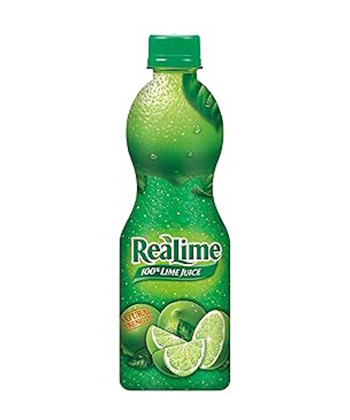
Clocking in at just a hair above sweet & sour mix is shelf-stable bottled lime juice. For this experiment, we used ReaLime. Compared to Zing Zang, the ingredient list is shorter: water, lime juice concentrate, and less than 2 percent lime oil, sodium benzoate, and sodium metabisulfite. The latter two are preservatives — sodium benzoate acts as an antimicrobial, while sodium metabisulfite serves as an antioxidant and disinfectant — helping make the juice shelf-stable until opened.
Visually, the Daiquiri looked true to form — clean and serviceable. But on the nose, the juice’s sharp acidity took center stage, overwhelming everything else. “On the nose, the juice itself has a bit more bite,” Kossoff said. “The other two substitutes we’ve tried so far [sweet & sour mix and Rose’s Lime Cordial] seemed to be trying to emulate the finish of lime, and I think this is all bite on the front without the lime-forward finish.”
The palate followed suit: abrasive lime acidity followed by bitterness. Like the sweet & sour mix, with a slightly adjusted spec, Kossoff felt the ReaLime could yield a serviceable Daiquiri for home guests, but not at a legitimate cocktail bar. Still, it skewed closer to the real deal than the Zing Zang did, and wasn’t terrible for a product of convenience.
Ranking: 4.5/10
Rose’s Lime Cordial
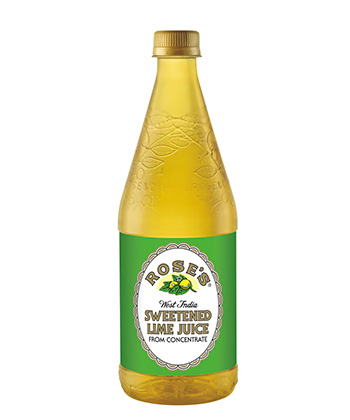
Rose’s Lime Cordial may be the butt of modern bar jokes, but it has a surprisingly rich history. After the British government passed the Merchant Shipping Act in 1867 — requiring all British merchant ships to stock rations of lime juice to prevent scurvy — Edinburgh’s Lauchlan Rose launched his namesake cordial. It quickly became a staple on ships leaving British ports, and sailors began mixing it with gin on their voyages. Just like that, the Gimlet was born.
These days, Rose’s Lime Cordial is still widely available, though its ingredients haven’t really kept up with the times. The bottle lists water, high-fructose corn syrup, lime juice concentrate, sodium metabisulfite, natural flavors, yellow dye #5, and blue dye #1.
So how did it hold up in a Daiquiri?
Actually, pretty well. The color looked right at first but faded to a translucent yellow tone after about a minute. Appearance aside, the flavor hit much better than expected. “There’s more lime character on the nose than we had with the Zing Zang, and it gives more of a citrusy pop up front,” Kossoff said. “This one is really surprising me.”
It certainly leaned sweet, and the artificial notes persisted through to the Daiquiri’s slightly cloying finish. Overall, though, we found Rose’s to be the most solid substitute among the store-bought, bottled alternatives we tested.
Ranking: 5.5/10
Lime Acid

As mentioned in the intro, Lime Acid doesn’t actually contain any lime juice. Developed by the team behind London’s now-shuttered White Lyan bar, the solution is a mix of water and a few other acids found in real lime juice, designed to mimic its flavor.
For this experiment, Kossoff prepared Monkey Thief’s house Lime Acid spec, which differs slightly from the original. “They use phosphoric acid, but we didn’t feel like we could taste it in the final product. We use citric acid, malic acid, tartaric acid, a little bit of salt, and water.” he explained. “We use it for carbonated cocktails at Monkey Thief. Things that are too dense, like lime juice, don’t carbonate well, so it’s a good substitute for that.”
Given that Lime Acid is mostly water, the finished Daiquiri had a thin texture. The color was also a little pale, lacking the vibrant tone that lime juice provides. On the bright side, the nose and flavor were both relatively balanced. “It’s a little salty, but it finishes dry and the balance is a lot better than I expected,” Kossoff said.
As bartender and food science writer Dave Arnold puts it in his book “Liquid Intelligence,” “I would never use [Lime Acid] instead of fruit, but it can be used to bolster fruit with a bit of acidity.” Kossoff echoed that sentiment, noting that “it’s not a 1:1 substitute for lime juice.” When it comes to sustainability, it doesn’t get any better than Lime Acid, but it’s not a viable standalone substitute for the real thing.
Ranking: 6.5/10
Day-Old Lime Juice
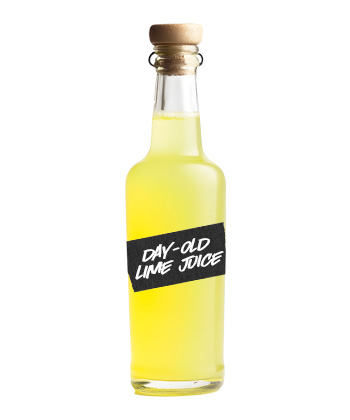
This batch of lime juice was squeezed 24 hours prior to our tasting, and stored in the fridge until go time.
For most bars, day-old lime juice is a cardinal sin, as after a full day, oxidation and enzymatic
bittering have done their damage. The latter is a process in which enzymes convert acidic compounds to bitter ones. While there is a sweet spot when those enzymes suppress the sour components of fresh juice and allow the drinker to enjoy its full spectrum of flavor, too much of it will diminish the juice’s character, making it taste astringently bitter and highly acidic. As Arnold writes in “Liquid Intelligence,” “I have run several taste tests of lime juice at different ages both in cocktails and in limeade. Not surprisingly, the day-old juice always loses.”
Still, we had to see how it stacked up. The color looked right, and the nose was solid. But true to Arnold’s findings, the taste was extremely acidic and threw the cocktail out of balance. “Consistency is really important,” Kossoff said. “In that regard, Lime Acid is gonna be more consistent than day-old lime juice, but they tasted about the same.”
If a bar has no choice but to use day-old lime juice, Kossoff recommended adjusting cocktail specs to cater for the shift in acidity. “My thought process is that you always have to taste [your lime juice],” he said. “We are the arbiters of what tastes good to the guest, so if you think your lime juice tastes a bit off, adjust your spec accordingly.” Still, if fresh limes are available, there’s no good reason to roll the dice with day-old juice.
Ranking: 6.5/10
Super Juice
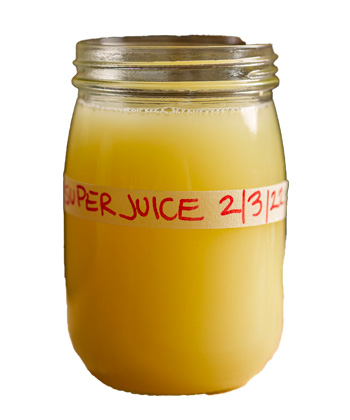
In layman’s terms, Super Juice is a sustainable citrus slurry developed in the late 2010s by bartender Nickle Morris of Louisville, Ky. It combines water, citric acid, malic acid, lime (or lemon) juice and peel to lengthen a batch of juice without losing any of its flavor. The citric acid acts as a preservative, the malic enhances tartness and gives a dry finish, and the oils from the peels contribute to overall flavor and complexity.
According to Arnold, “the acidity of [real] lime juice is roughly 4 percent citric and 2 percent malic with a tiny bit of succinic acid.” Since succinic acid contributes to oxidation, Super Juice omits it. When made properly, Super Juice yields six times as much liquid as traditional juicing and lasts for one to two weeks when refrigerated.
The catch with Super Juice is consistency. As with standard lime juice, the fruit can vary depending on the batch. Plus, when blending Super Juice — the last step in its recipe — processing for a bit too long can allow small bits of peel that would otherwise get strained out to make their way into the final product.
Despite those potential hiccups, the Monkey Thief Super Juice held up well. The Daiquiri’s presentation and scent passed the test, though the drink was just a tad bitter. “There are a lot of variables at work here,” Kossoff said. “But it’s still a pretty good Daiquiri. And lime prices are getting expensive, so this totally makes sense for a bar as long as they can keep their Super Juice consistent.”
Ranking: 7.5/10
Four-Hour-Old Lime Juice

Lime juice squeezed a few hours before use is what most cocktail bars rely on — and some even prefer it to juice prepped à la minute. As a Tales of the Cocktail article states, “tasting notes described four-hour-old lime juice as ‘more mellow’ and ‘well-balanced’ compared to its fresh counterpart and after the blissful first 10 hours, bitterness increased perceptibly with an accompanying loss of flavor.”
Of course, taste is subjective, so we had to find out for ourselves. Kossoff’s Daiquiri with several-hour-old lime juice was certainly a crowd-pleaser: balanced, smooth, and all-around delicious. It frothed up nicely, and both the color and scent were spot on. That said, we did feel there was a little room for improvement. Maybe it was the anticipation of fresh-squeezed lime coming next, but everything here was more or less in harmony.
“As lime ages, especially if it’s not refrigerated, it’s gonna get more bitter,” Kossoff said. “But that’s a very good Daiquiri. Most places juice early in the day, so it tastes familiar to me.”
Ranking: 8.5/10
Lime Juice Squeezed À La Minute

For the finale, we juiced a lime straight into the jigger. “We expect that the fresher the lime juice, the better the Daiquiri is going to be,” Kossoff said. “But most bars don’t have the time to juice fresh to order.” And it’s true — juicing limes every time somebody orders a Margarita or Daiquiri may impress the guest, but it inevitably slows down service. The bigger question, though: is it better or worse than juice that’s been mellowed by enzymatic bittering?
During our tasting, the resounding answer was yes. From appearance and nose to taste and mouthfeel, it was flawless — a pillowy, boozy trifecta of rum, lime, and sugar with no oxidation or off-flavors to throw the symphony out of tune. “I can’t be mad about anything here,” Kossoff said. “As we expected, it’s a 10 out of 10.”
Ranking: 10/10
Final Thoughts
We can say with confidence that sweet & sour mix and even day-old lime juice don’t hold a candle to the fresher and more prep-heavy alternatives. As for the final two contestants and their discrepancies, Arnold puts it best: “The lime juice that is several hours old usually wins over lime juice that is super fresh,” he writes. “My cocktail compatriot Don Lee ran this same test with a bunch of European bartenders, who typically juice their limes à la minute. They tended to choose fresh juice over any of the other batches. Best, therefore, may just be what you are used to.”
